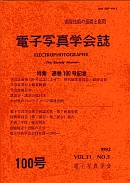Volume 32, Issue 2
Displaying 1-22 of 22 articles from this issue
- |<
- <
- 1
- >
- >|
-
1993Volume 32Issue 2 Pages 60-71
Published: 1993
Released on J-STAGE: May 31, 2007
Download PDF (1414K) -
1993Volume 32Issue 2 Pages 72-78
Published: 1993
Released on J-STAGE: May 31, 2007
Download PDF (762K) -
1993Volume 32Issue 2 Pages 79-87
Published: 1993
Released on J-STAGE: May 31, 2007
Download PDF (3267K) -
1993Volume 32Issue 2 Pages 88-93
Published: 1993
Released on J-STAGE: May 31, 2007
Download PDF (1536K) -
1993Volume 32Issue 2 Pages 94-99
Published: 1993
Released on J-STAGE: May 31, 2007
Download PDF (1658K) -
1993Volume 32Issue 2 Pages 100-109
Published: 1993
Released on J-STAGE: May 31, 2007
Download PDF (1896K) -
1993Volume 32Issue 2 Pages 110-116
Published: 1993
Released on J-STAGE: May 31, 2007
Download PDF (1874K) -
1993Volume 32Issue 2 Pages 117-123
Published: 1993
Released on J-STAGE: May 31, 2007
Download PDF (2164K) -
1993Volume 32Issue 2 Pages 132-137
Published: 1993
Released on J-STAGE: May 31, 2007
Download PDF (670K) -
1993Volume 32Issue 2 Pages 138-141
Published: 1993
Released on J-STAGE: May 31, 2007
Download PDF (914K) -
1993Volume 32Issue 2 Pages 142-147
Published: 1993
Released on J-STAGE: May 31, 2007
Download PDF (1305K) -
1993Volume 32Issue 2 Pages 148-153
Published: 1993
Released on J-STAGE: May 31, 2007
Download PDF (1334K) -
1993Volume 32Issue 2 Pages 149-157
Published: 1993
Released on J-STAGE: May 31, 2007
Download PDF (866K) -
1993Volume 32Issue 2 Pages 154-158
Published: 1993
Released on J-STAGE: May 31, 2007
Download PDF (1258K) -
1993Volume 32Issue 2 Pages 159-164
Published: 1993
Released on J-STAGE: May 31, 2007
Download PDF (2138K) -
1993Volume 32Issue 2 Pages 165-171
Published: 1993
Released on J-STAGE: May 31, 2007
Download PDF (1890K) -
1993Volume 32Issue 2 Pages 172-175
Published: 1993
Released on J-STAGE: May 31, 2007
Download PDF (658K) -
1993Volume 32Issue 2 Pages 176-178
Published: 1993
Released on J-STAGE: May 31, 2007
Download PDF (968K) -
1993Volume 32Issue 2 Pages 179-183
Published: 1993
Released on J-STAGE: May 31, 2007
Download PDF (544K) -
1993Volume 32Issue 2 Pages 184-188
Published: 1993
Released on J-STAGE: May 31, 2007
Download PDF (2166K) -
1993Volume 32Issue 2 Pages 189-191
Published: 1993
Released on J-STAGE: May 31, 2007
Download PDF (1045K) -
1993Volume 32Issue 2 Pages 192-195
Published: 1993
Released on J-STAGE: May 31, 2007
Download PDF (941K)
- |<
- <
- 1
- >
- >|
